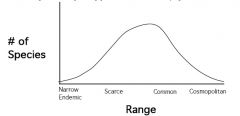![]()
![]()
![]()
Use LEFT and RIGHT arrow keys to navigate between flashcards;
Use UP and DOWN arrow keys to flip the card;
H to show hint;
A reads text to speech;
5 Cards in this Set
- Front
- Back
|
Endemism
|
- condition of being restricted in
distribution to a particular region. When a species is referred to as being “endemic,” a geographic region must be specified (e.g., Lewisia tweedyi is endemic to Washington, or Campanula piperi is endemic to the Olympic mountains). |
|
|
Descrie four types of ranges of species
|

Narrow endemic - very restricted distribution
Scarce - widely distributed, but never very abundant Common - Regional distribution; abundant somewhere Cosmopolitan - found everywhere (e.g., Bracken fern); this is unusual - <10% of spp. |
|
|
Two types of narrow endemics
|
Paleoendemics - ancient origin, left over from wider distribution, and typically have no
closely related species Examples: Sequoia sempervirens (Coast Redwood) in California Kalmiopsis leachiana in Siskiyous (Oregon) – named for Lila Leach Microcycas in Cuba – every plant is known and counted Metasequoia glyptostroboides – first described as a fossil, but then discovered in 1940’s in Hupei province in China 59 Neoendemics - recent in origin (typically post-Tertiary in origin) and typically have closely related species nearby eg, allopolyploids (species derived from hybridization and chromosome doubling, so the parent species are still around) and peripherally isolated species from more widespread species Examples: Erigeron piperianus endemic to eastern Washington is a recently derived offshoot of the widespread Erigeron linearis, found throughout the intermountain region. Stephanomeria malheurensis known from one very small locality in eastern Oregon, where it is distinguishable from its progenitor species by smaller flowers and self-fertilizing mating system. |
|
|
Describe kinds of rarity in terms of geographic range and habitat specificity
|

see chart
|
|
|
Discuss three environmental determinants of rarity
|
1) Habitat Specificity - geo-edaphic factors; discontinuous distribution of sites favorable
to particular plant; isolation can lead to speciation. Serpentine endemics in California and Oregon (and elsewhere around the world) are good examples of this. 2) Local Climate/Regional Climate - some paleoendemics may occupy “relictual climates” (eg, similar to climates in the Tertiary, before the Ice ages). An example is the Dawn Redwood (Metasequoia glyptostroboides), found only in a small valley in China, but once very widespread. The “Arcto-Tertiary flora” is based on this concept. Related plants in eastern North America, Europe, and Eastern Asia represent the remnants of a once widespread flora that covered all of the northern latitudes when the climate was milder. 3) Biotic factors - the interaction between species, including plant dependence on pollinators that may be rare or extinct. Example is Kincaid’s lupine in the Willamette Valley in Oregon, which is pollinated by a rare butterfly. This is believed to be responsible for some of the rare plants in Hawaii, which no longer have native pollinating birds. |

